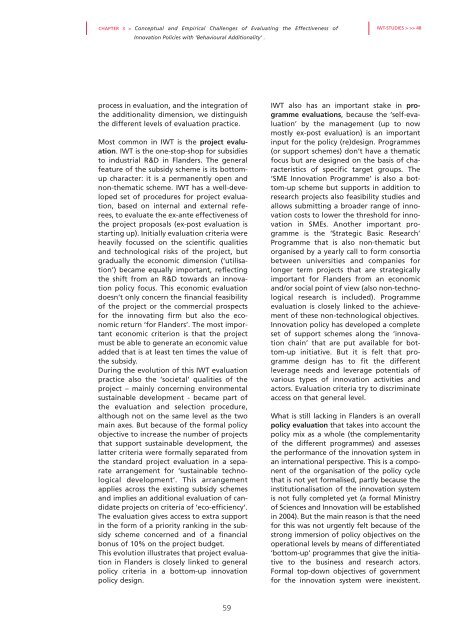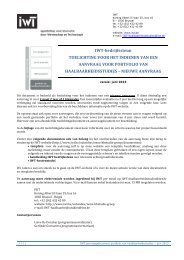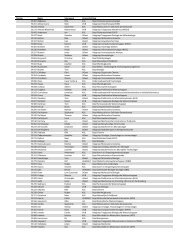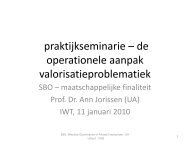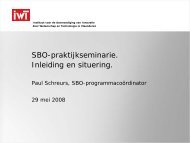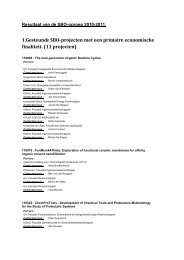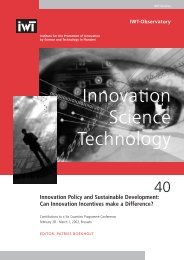The Evaluation of 'Behavioural Additionality' - IWT
The Evaluation of 'Behavioural Additionality' - IWT
The Evaluation of 'Behavioural Additionality' - IWT
You also want an ePaper? Increase the reach of your titles
YUMPU automatically turns print PDFs into web optimized ePapers that Google loves.
CHAPTER 3 > Conceptual and Empirical Challenges <strong>of</strong> Evaluating the Effectiveness <strong>of</strong><br />
Innovation Policies with ‘Behavioural Additionality’ .<br />
<strong>IWT</strong>-STUDIES > >> 48<br />
process in evaluation, and the integration <strong>of</strong><br />
the additionality dimension, we distinguish<br />
the different levels <strong>of</strong> evaluation practice.<br />
Most common in <strong>IWT</strong> is the project evaluation.<br />
<strong>IWT</strong> is the one-stop-shop for subsidies<br />
to industrial R&D in Flanders. <strong>The</strong> general<br />
feature <strong>of</strong> the subsidy scheme is its bottomup<br />
character: it is a permanently open and<br />
non-thematic scheme. <strong>IWT</strong> has a well-developed<br />
set <strong>of</strong> procedures for project evaluation,<br />
based on internal and external referees,<br />
to evaluate the ex-ante effectiveness <strong>of</strong><br />
the project proposals (ex-post evaluation is<br />
starting up). Initially evaluation criteria were<br />
heavily focussed on the scientific qualities<br />
and technological risks <strong>of</strong> the project, but<br />
gradually the economic dimension (‘utilisation’)<br />
became equally important, reflecting<br />
the shift from an R&D towards an innovation<br />
policy focus. This economic evaluation<br />
doesn’t only concern the financial feasibility<br />
<strong>of</strong> the project or the commercial prospects<br />
for the innovating firm but also the economic<br />
return ‘for Flanders’. <strong>The</strong> most important<br />
economic criterion is that the project<br />
must be able to generate an economic value<br />
added that is at least ten times the value <strong>of</strong><br />
the subsidy.<br />
During the evolution <strong>of</strong> this <strong>IWT</strong> evaluation<br />
practice also the ‘societal’ qualities <strong>of</strong> the<br />
project – mainly concerning environmental<br />
sustainable development - became part <strong>of</strong><br />
the evaluation and selection procedure,<br />
although not on the same level as the two<br />
main axes. But because <strong>of</strong> the formal policy<br />
objective to increase the number <strong>of</strong> projects<br />
that support sustainable development, the<br />
latter criteria were formally separated from<br />
the standard project evaluation in a separate<br />
arrangement for ‘sustainable technological<br />
development’. This arrangement<br />
applies across the existing subsidy schemes<br />
and implies an additional evaluation <strong>of</strong> candidate<br />
projects on criteria <strong>of</strong> ‘eco-efficiency’.<br />
<strong>The</strong> evaluation gives access to extra support<br />
in the form <strong>of</strong> a priority ranking in the subsidy<br />
scheme concerned and <strong>of</strong> a financial<br />
bonus <strong>of</strong> 10% on the project budget.<br />
This evolution illustrates that project evaluation<br />
in Flanders is closely linked to general<br />
policy criteria in a bottom-up innovation<br />
policy design.<br />
<strong>IWT</strong> also has an important stake in programme<br />
evaluations, because the ‘self-evaluation’<br />
by the management (up to now<br />
mostly ex-post evaluation) is an important<br />
input for the policy (re)design. Programmes<br />
(or support schemes) don’t have a thematic<br />
focus but are designed on the basis <strong>of</strong> characteristics<br />
<strong>of</strong> specific target groups. <strong>The</strong><br />
‘SME Innovation Programme’ is also a bottom-up<br />
scheme but supports in addition to<br />
research projects also feasibility studies and<br />
allows submitting a broader range <strong>of</strong> innovation<br />
costs to lower the threshold for innovation<br />
in SMEs. Another important programme<br />
is the ‘Strategic Basic Research’<br />
Programme that is also non-thematic but<br />
organised by a yearly call to form consortia<br />
between universities and companies for<br />
longer term projects that are strategically<br />
important for Flanders from an economic<br />
and/or social point <strong>of</strong> view (also non-technological<br />
research is included). Programme<br />
evaluation is closely linked to the achievement<br />
<strong>of</strong> these non-technological objectives.<br />
Innovation policy has developed a complete<br />
set <strong>of</strong> support schemes along the ‘innovation<br />
chain’ that are put available for bottom-up<br />
initiative. But it is felt that programme<br />
design has to fit the different<br />
leverage needs and leverage potentials <strong>of</strong><br />
various types <strong>of</strong> innovation activities and<br />
actors. <strong>Evaluation</strong> criteria try to discriminate<br />
access on that general level.<br />
What is still lacking in Flanders is an overall<br />
policy evaluation that takes into account the<br />
policy mix as a whole (the complementarity<br />
<strong>of</strong> the different programmes) and assesses<br />
the performance <strong>of</strong> the innovation system in<br />
an international perspective. This is a component<br />
<strong>of</strong> the organisation <strong>of</strong> the policy cycle<br />
that is not yet formalised, partly because the<br />
institutionalisation <strong>of</strong> the innovation system<br />
is not fully completed yet (a formal Ministry<br />
<strong>of</strong> Sciences and Innovation will be established<br />
in 2004). But the main reason is that the need<br />
for this was not urgently felt because <strong>of</strong> the<br />
strong immersion <strong>of</strong> policy objectives on the<br />
operational levels by means <strong>of</strong> differentiated<br />
‘bottom-up’ programmes that give the initiative<br />
to the business and research actors.<br />
Formal top-down objectives <strong>of</strong> government<br />
for the innovation system were inexistent.<br />
59


